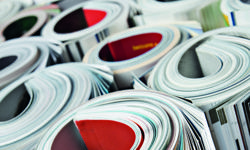Which are the ten British-born titles that have had the greatest influence on first the market and then the media in the years since the war? It's an interesting question because it's not simply a question of commercial success on the one hand or approval from the chattering classes on the other hand. If it were, then it would be Radio Times for the former and Nova for the latter.
My list is only one magazine professional's point of view. There are hardly any women's magazines on my list. That's partly because most of them have tended to be imports of formulae that were successful elsewhere. Even Vogue, which seems distinctly British, started in the USA. The market leading women's titles that were home-grown (titles such as Woman) have attracted a great deal of imitators, which is not quite the same as being influential. I've got a soft spot for She, which was a reliable source of naughtiness back in the 60s when most women's magazines wore an extra cardigan to keep naughtiness at bay. Similarly, there are no men's magazines on my list. Loaded and FHM were the obvious candidates but they both waxed and waned too quickly to be counted. There are some that had a profound effect on one generation but never really moved on: Jackie, Honey, Max Power, even Oz.
This list, which is in no particular order, does not contain anything best known for lovely use of typography. Art directors and academics, please move along. They've instead been chosen for the way they have reflected, informed or influenced different aspects of British life and planted seeds which are, sometimes controversially, still flowering today.
The Spectator
The Spectator's influence can be discerned in the rumbling note of exasperation and scepticism that can be found in the opinion section of almost every national newspaper, the number of former editors and contributors (such as Nigel Lawson and Boris Johnson) who have attained real power in British public life and in a format which really shouldn't work in this multi-coloured, all bells and whistles present but somehow magnificently does. The idea that a magazine need only be a lens through which you can look at everything from politics to food and drink is a notion that has influenced everyone from the American Spectator to the New Statesman, its companion at the other end of the political spectrum. While cultivating its bufferish image, it has elegantly extended itself on to digital platforms in a way envied by other publishers large and small.
Picture Post
Very few of the people whose work is done in the shadow of Picture Post have even seen a copy. It started in 1938 and closed twenty years later when its circulation was down to a then-unsustainable 600,000 a week. Its core was the photo story, presented with deep, informative captions, much like a comic for adults. Like any magazine that knows the value of a circulation spike, it had to spice up its diet of "let's all pull together" pieces about the war effort ("Refugees: allies or enemies?") with wholly gratuitous picture spreads such as "the history of the corset". Its greatest legacy is the establishment of what came to be called "lifestyle" as demonstrated in its excited peeps beneath the pavements of Soho to investigate the emerging trad jazz and skiffle booms.
The Sunday Times Magazine
People of a certain age still say "it's the kind of thing you would see in the colour supplements". This conjures up a vision of an article about a beautiful young actress next to a full colour advert for the holiday of a lifetime. Turn the page and there's an eye watering piece about coming of age rituals on South Sea islands, an extract from a new book about a high profile murderer and an ad for the car you wish you could afford. At the back will be a rip-off of the Sunday Times Life In The Day Of, just one small indication of how influential this magazine, launched in 1962, has been among its competitive set and beyond.
Private Eye
Every ten years, a bunch of wise guys come out with a plan to produce a satirical magazine - "but not like Private Eye". They point out that Private Eye has been telling essentially the same jokes for a lifetime – Street of Shame, Pseuds Corner, a running gag about the current Prime Minister, a topical photograph with a puerile caption on the cover – and that a new generation demands a new approach to humour. What they fail to notice is that Private Eye's core strength is that it has been telling the same jokes for all that time and, most miraculously, it has resisted any attempt to "improve" its production values. It's been going over fifty years and in that time it's only had two editors. There is no greater advert in British media, or in British anything, for the power of format and the value of conservatism than Private Eye.
Time Out
If only on the basis of its scores of international editions which are published on the same template, Time Out is clearly one of British magazine publishing's most influential magazines. But it's also played a role in forging the image of modern London. When it started in the late 60s, it was promoting an "alternative society" that was not reflected in the mainstream media. In the forty years since, it's watched the alternative supplant the mainstream. Without Time Out, the city's burgeoning sub-cultures (musical, theatrical, fringe, gay, children's) would not have been able to find their feet in the way they have done. It sells London's image to an increasing cosmopolitan population and promotes the idea of the city as a magnet for young people who are as likely to go to Tate Modern as West Ham. It was a must-buy in the era when it was the only way to find out what was on at your local cinema but it also presented you with a myriad of possibilities. Most people got exhausted just reading it, but the thought was there.
Foul
Nobody reading this will have even heard of Foul, a cheaply produced football magazine briefly available in the mid-70s. It was the first shot in a war that led not only to When Saturday Comes and Four Four Two but also hundreds of club-specific football fanzines knocked out up and down the country to this day. It also introduced a way of looking at football - romantic, sceptical, humorous, passionate and essentially pessimistic - that runs through our affair with the national game. It was started by Andrew Nickolds and Stan Hey (who subsequently became comedy writers) and embodied the great truth that in football, it's not the despair that kills you, it's the hope that gets you every time, long before Nick Hornby.
Tatler
There's been a magazine operating under the name of The Tatler since 1709, so it's reasonable to assume that it's enjoyed many periods when it's been greatly influential. Its key post-war purple patch was in the early 80s when the then inexperienced Tina Brown was handed the reins with the brief that an editor most likes to hear - "unless you've got a better idea we're closing it". She proceeded to blow the thin layer of face powder off this crusty old dowager and, with the help of her star, Diana, Princess of Wales, to celebrate wealth and glamour in a cake-and-eat-it way. Observing the truth that you can say anything you want to about people in the body copy as long as you make them look fabulous in the picture, she celebrated Big Bang financiers, aristocrats with trouser problems and photogenic counter jumpers. After three years, she took the same approach to New York and Vanity Fair.
Smash Hits
Full disclosure. I worked on Smash Hits, which started in 1978, reached its peak in the mid-80s (there was one issue which sold within touching distance of a million copies) and closed in 2006. It not only gave a start to Mark Ellen, Ian Birch, Steve Bush, Mike Soutar, Mark Frith, Miranda Sawyer, Chris Heath and somebody called Neil Tennant, it also pioneered a whole new way of presenting magazine material on a page - densely detailed, bristling with jokes, deeply affectionate about its subject matter and very respectful of its readers - which can be traced through to everything from The Face to Q to Elle to Heat to The Guardian Guide and finally to lots of titles who think they're above this sort of thing.
More!
Partial disclosure. I was involved with this young women's magazine which launched in 1988 but its success was all down to a succession of editors led by Fiona Gibson who frankly couldn't believe they were getting away with a magazine for older teenage girls with a regular called "position of the fortnight". Its massive success led to the eye-watering frankness now taken for granted in such programmes as How To Look Good Naked, freed up the older women's magazines to step boldly into areas they'd never strayed into before and also made it possible for IPC to launch Loaded. So much for the ladettes following the lads. It was actually the other way round.
Viz
No television series has released as many jokes into the wild as this comic magazine, launched from the Donald home in Jesmond in 1979. It's not just the characters - Sid The Sexist, Buster Gonad and the Fat Slags, which took the rude stereotypes of children's comics and relocated them to the union bar - it's also something in the bathos of the humour that chimed with the British personality in the 80s and 90s. The Viz Top Tips, the stories featuring not quite glamorous television personalities, the urgent need to hack away at any chance of your own celebrity - all these things are at work every time you hear Chris Evans broadcast or see a TV advert aimed at young people. Viz is, as they say themselves, not as funny as it used to be, but it nonetheless rewired the heads of millions of people.










